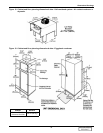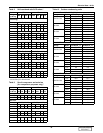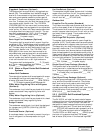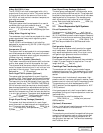
The optional Advanced control processor shall be
microprocessor based with a front monitor dot matrix
display panel and control keys for user inputs. The
controls shall be menu driven with on-screen
prompts for easy user operation. The system shall
allow user review and programming of temperature
and humidity setpoints, alarm parameters, and
setup selections including choice of control type. A
password shall be required to make system changes.
For all user selections, the range of acceptable input
(temperature, humidity, or time delay) shall be dis-
played on the monitor screen. The system shall pro-
vide monitoring of room conditions, operational
status in % of each function, component run times,
date and time, and four analog inputs from sensors
provided by others.
Control
The control system shall allow programming of the
following room conditions:
Temperature Setpoint 65 to 85°F (18-29°C)
Temperature Sensitivity +1 to +9.9°F (0.6 to
5.6°C) in 0.1° increments
Humidity Setpoint 20 to 80% RH
Humidity Sensitivity +1 to +30% RH
All setpoints shall be adjustable from the individual
unit front monitor panel.
Temperature and Humidity Sensors shall be capable
of being calibrated using the front monitor panel con-
trols to coordinate with other temperature and
humidity sensors in the room.
Predictive Humidity Control
The microprocessor shall calculate the moisture con-
tent in the room and prevent unnecessary humidifi-
cation and dehumidification cycles by responding to
changes in dew point temperature.
Compressor Short-Cycle Control
The control system shall include a program to pre-
vent compressor short-cycling.
System Auto-Restart
For start-up after power failure, the system shall
provide automatic restart with a programmable (up
to 9.9 minutes in 6-second increments) time delay.
Programming can be performed either at the unit or
from the central site monitoring system.
Sequential Load Activation
During start-up, or after power failure, the micropro-
cessor shall sequence operational load activation to
minimize inrush current. Systems allowing multiple
loads to start simultaneously are unacceptable.
Chilled Water/Hot Water/Econ-O-Coil Flush
Cycles
Chilled water, hot water, and Econ-O-Cool coils shall
be automatically flushed to prevent the buildup of
contaminants. Systems without this feature shall
include the necessary devices to bypass fluid into the
coil on a programmed basis.
Front Monitor Display Panel
The microprocessor shall provide a front monitor 240
x 120 dot matrix display panel with adjustable back-
lighting. This display (along with five front mounted
control keys) shall be the only operator interface
required to obtain all available system information
such as room conditions, operational status, graphi-
cal data, alarms, control and alarm setpoints, and all
user selections including alarm delays, sensor cali-
bration, DIP switch selections, and diagnostics. All
indicators shall be in language form. No symbols or
codes shall be acceptable.
Alarms
The microprocessor shall activate an audible and
visual alarm in event of any of the following condi-
tions:
High Temperature
Low Temperature
High Humidity
Low Humidity
Short Cycle
Compressor Overload (Optional)
Main Fan Overload (Optional)
Humidifier Problem
High Head Pressure
Change Filter
Loss of Air Flow
Low Suction Pressure
Loss of Power
Custom Alarm (#1 to #4)
Custom alarms are four customer accessible alarm
inputs to be indicated on the front panel. Custom
alarms can be identified with prepared (pro-
grammed) alarm labels for the following frequently
used inputs:
Water Under Floor
Smoke Detected
Standby GC Pump On
Loss of Water Flow
Standby Unit On
User-customized text can be entered for all four cus-
tom alarms. Each alarm (unit and custom) can be
separately enabled or disabled, selected to activate
the common alarm, and programmed for a time delay
of 0 to 255 seconds.
Audible Alarm
The audible alarm shall annunciate any alarm that
is enabled by the operator.
DISCONTINUED
PRODUCT


















